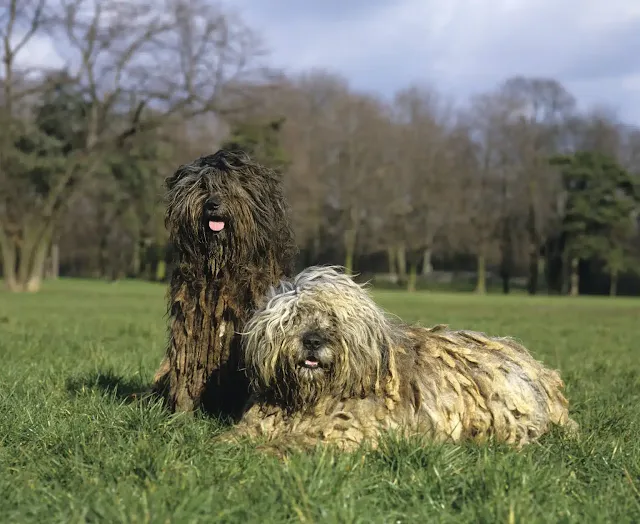Dogs With Dreadlocks: What Are Corded Dog Breeds?
 |
We humans refer to them as "dreadlocks," but in the dog world, the actual term for this type of coat is "cords." They are also known as "flocks" or "mats" at times.
Corded dog breeds are those with this style of coat. This article will go into the perplexing world of these dogs. Continue reading to learn more about them!
Corded dog breeds are those with hair rather than fur. And they are not born with cords, but rather with curled hair that develops into mats and, later, cords as they mature.
WHAT CAUSES DREADLOCKS IN CORDED DOG BREEDS?
Dogs with dreadlocks go through a matting process in which the owner becomes involved in forming the mats into cords correctly.
A corded dog's hair will gradually become coarse as it grows. Around nine months, the coarse hair begins to form mats, particularly around their ears, limbs, legs, and underarms.
Once the matting begins, certain dog breeds' hair may naturally cord up. However, some dogs' hair does not naturally curl or tangle into cords. Their owners, however, can assist them in forming cords because they have thick, curly hair.
CARE FOR A DOG WITH DREADLOCKS
Tangled hair, among other things, can readily accumulate dirt, mud, twigs, leaves, and dust. So, here are a few pointers to keep in mind when caring for your corded companion:
CORD FORMATION
Here are some helpful hints for making the cords:
- The mats should not be brushed or combed.
- If the coat is still fine, tear the matting by hand to separate into little bits.
- Do not, however, tug the dog's hair with your hands if the coat is coarse. Use a scissor to assist you.
- Work in a series of brief sessions. It can take a long time to split the matting. Don't worry if you can't finish it all in one sitting.
- Watch as the hair begins to coil into cords after splitting.
- Keep in mind that changing the dog's cords is a lengthy procedure. Dogs with dreadlocks may achieve their ideal cords after a year or two.
MAINTENANCE OF THE CORDS
- Once the cords have formed appropriately, you should trim (NOT cut) the hair to around three inches in length once a year.
- Hair around their eyes, ears, legs, and paws should be trimmed.
- Bathe the dog every few weeks to a month, depending on their lifestyle.
- When bathing, ensure that the water and shampoo/conditioner fully permeate the cords.
- Use a gentle shampoo and a hydrating conditioner.
- Rinse off all of the shampoo and conditioner from the cords.
- When drying a dog with dreadlocks, use a blow dryer to ensure that they are thoroughly dry. This is an absolutely necessary step. Because wires can trap dirt and promote the growth of bacteria and mildew. Additionally, air-drying a corded coat might take up to 48 hours.
However, if you are unable to complete all of these tasks on your own, it is always preferable to consult with a professional dog groomer.
6 COMMON CORDED DOG BREEDS
See below for information on six popular breeds of dogs with dreadlocks.
1. KOMONDOR
 |
| Everita Pane / Shutterstock.com |
The Komondor is arguably the most well-known corded dog breed, having been officially designated as one of Hungary's national treasures. They are also one of the dogs with dreadlocks that develop naturally.
They are also a huge livestock guarding dog with white dreadlocks. And because of their eye-catching, tangled appearance and enormous size, this breed is impossible to overlook.
The Komondor is both powerful and protective, but it can also be sweet and caring. And, because to its white ropes, it may blend in with the flock of sheep it defends, catching predators off guard!
They are also a huge livestock guarding dog with white dreadlocks. And because of their eye-catching, tangled appearance and enormous size, this breed is impossible to overlook.
The Komondor is both powerful and protective, but it can also be sweet and caring. And, because to its white ropes, it may blend in with the flock of sheep it defends, catching predators off guard!
2.HUNGARIAN PULI
 |
| Sue Thatcher / Shutterstock.com |
The Hungarian Puli is similar to the Komondor in that it grows up with natural-forming cords and is from Hungary. They resemble Komondors, but are smaller.
Unlike the Komondor, the Puli are herding dogs. As a result, they are active dogs. They are protected from harsh winter circumstances because to their heavily corded coats.
Furthermore, because they are bred to work closely with humans, they make excellent family pets. They are devoted, compassionate, and wise.
Unlike the Komondor, the Puli are herding dogs. As a result, they are active dogs. They are protected from harsh winter circumstances because to their heavily corded coats.
Furthermore, because they are bred to work closely with humans, they make excellent family pets. They are devoted, compassionate, and wise.
3.SHEEPDOG BERGAMASCO
 |
| volofin / Shutterstock.com |
What’s the difference between the above mentioned breeds’ cords with the Bergamasco’s flocks? Unlike cords, this breed’s flocks are irregularly large, flat and wide. Flocks can look like cords but with fan-like ends. So, the overall look of the dog is not like a “mop” at all.
Furthermore, among the dogs with dreadlocks, the Bergamasco Sheepdog’s coat is very unique because it consists of three types of hairs: a woolly outer coat, a long and rugged coat (referred to as “goat hair”), and a fine, dense, and oily undercoat.
4. SPANISH WATER DOG
 |
| Kevin George / Shutterstock.com |
They are employed in the herding of cattle, sheep, and goats. They are also excellent waterfowl retrievers, so YES, they enjoy the water! As a result, its coat is water-resistant and provides a layer of insulation to keep them warm while in the water.
Furthermore, for its cords to form, the Spanish Water Dog needs a special grooming requirement. You must thoroughly shave its coat and then let the hair grow out without brushing or combing it. The hair will then begin to cord at this point. Of course, a hooman's assistance is required to properly construct the cords!
In addition, unlike other dogs with dreadlocks, the Spanish Water Dog has only one coat. The coat, on the other hand, is thick, woolly, and curling as it grows.
5.HAVANESE
The Havanese is the smallest of the dreadlocked dog breeds. Their lengthy coat is naturally light and slightly wavy. And most Havanese dogs get their hair combed out.
However, because they have long, slightly wavy hair, they are prone to mat formation. So, in order for their hair to transform into cords, their owner must tear the mats in their hair and separate them into parts, allowing the cords to form.
However, you must be patient; it can take a Havanese dog two years to acquire the perfect cords!
However, because they have long, slightly wavy hair, they are prone to mat formation. So, in order for their hair to transform into cords, their owner must tear the mats in their hair and separate them into parts, allowing the cords to form.
However, you must be patient; it can take a Havanese dog two years to acquire the perfect cords!
6. POODLE
Cording does not come naturally to any of the dogs with dreadlocks we've mentioned. Their thick and curly coat can be corded with the assistance of a hooman. Furthermore, while Standard Poodles have the most dreadlocks, Toy and Miniature Poodles' hair can also be corded.
Poodle dogs with dreadlocks are uncommon because they lack natural chord formation.
CONCLUSION
If you're thinking about adopting or purchasing a corded dog, you should conduct your study on the breed and understand the rigorous grooming requirements.
It is also critical to ensure that you are prepared for the obligations and are willing to dedicate time and finances to properly care for such a dog.




Post a Comment